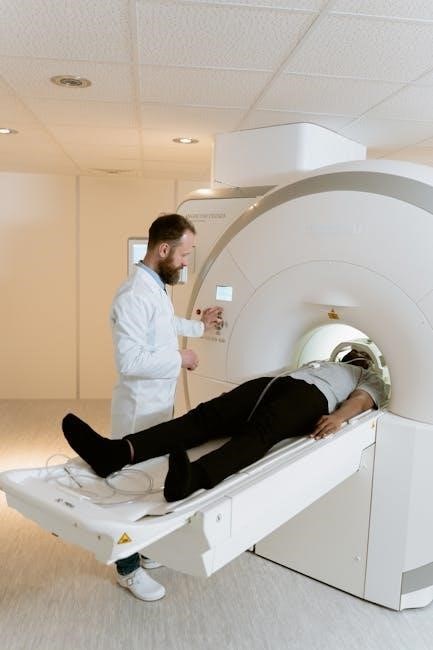Dressage is a highly precise equestrian discipline emphasizing harmony between horse and rider. It introduces foundational skills, building a strong partnership and preparing for advanced competitions.
1.1 What Is Dressage?
Dressage is a precise and elegant equestrian discipline that focuses on the harmonious partnership between horse and rider. It involves a series of predetermined movements performed in an arena, showcasing the horse’s obedience, balance, and athleticism. The term “dressage” originates from the French word for “training,” reflecting its roots in classical equitation. At its core, dressage aims to develop the horse’s natural gaits and movements while enhancing its responsiveness to the rider’s aids. It is often referred to as the “ballet of horse and rider” due to its grace and precision. Dressage is not only a competitive sport but also a foundational training method that improves communication and trust between horse and rider, preparing them for advanced disciplines and competitions.
1.2 Importance of Dressage Tests
Dressage tests are essential for assessing the skills and progression of both horse and rider. They provide a structured framework to evaluate the understanding of fundamental movements and communication. By participating in dressage tests, riders gain insight into their horse’s responsiveness and athleticism, while judges’ feedback offers constructive guidance for improvement. These tests also serve as a stepping stone for competitive riders, helping them build confidence and refine their techniques. Additionally, dressage tests encourage the development of a strong partnership between horse and rider, fostering trust and mutual understanding. They are a cornerstone in equestrian training, offering a clear path for progression and mastery of the discipline.
1.3 Dressage Levels for Beginners
Dressage offers structured levels designed to guide beginners through their equestrian journey. The introductory level focuses on basic skills, such as walking, trotting, and halting, helping riders establish clear communication with their horses. As riders progress, they move through training and first levels, introducing more complex movements like circles and leg yields. These levels build a solid foundation, emphasizing balance, rhythm, and suppleness; They also help riders develop control and confidence, preparing them for higher-level competitions. The gradual progression ensures that both horse and rider can master each skill before advancing, fostering a strong, trusting partnership.

Purpose of the Introductory Dressage Test
The introductory dressage test introduces riders and horses to the sport, assessing foundational skills like balance, rhythm, and communication, while fostering a strong partnership and confidence.
The introductory dressage test serves as the first step for riders and horses entering the sport. It is designed to evaluate basic skills, such as the ability to perform simple movements, maintain rhythm, and demonstrate clear communication between the rider and the horse. The test is typically conducted in a smaller arena, reducing the intimidation factor for newcomers; It focuses on foundational elements like walking, trotting, and halting, ensuring that both the rider and horse are comfortable and prepared for more advanced challenges. This initial assessment helps build confidence and establishes a solid foundation for future progress in dressage.
2.2 Developing Horse and Rider Partnership
The introductory dressage test plays a crucial role in fostering a strong partnership between horse and rider. By focusing on clear communication and mutual understanding, the test helps establish trust and coordination. Riders learn to use subtle aids, while horses become responsive to these cues. This collaboration enhances balance, rhythm, and overall performance. The test environment encourages patience and calmness, essential for building a harmonious relationship. As riders and horses progress, this foundation supports more complex movements and challenges, making the introductory test a vital stepping stone in their dressage journey.

Structure of the Introductory Dressage Test
The test includes a series of predetermined patterns and movements, such as walking, trotting, and halting, performed in a standardized arena, introducing riders and horses to dressage fundamentals.
3.1 Components of the Test
The introductory dressage test consists of a series of pre-determined movements and patterns designed to assess the horse and rider’s basic skills. These components include walking, trotting, and halting, as well as simple transitions between gaits. The test pattern is carefully structured to evaluate the horse’s obedience, balance, and harmony with the rider. It also introduces foundational dressage concepts, such as maintaining a steady rhythm and correct alignment. The test is designed to be straightforward for newcomers while still challenging enough to showcase their developing skills. By focusing on these key elements, the test provides a clear starting point for both horse and rider to build their dressage journey.
3.2 Patterns and Movements
The introductory dressage test features simple yet foundational patterns and movements to evaluate the horse and rider’s coordination. These include straight lines, 20-meter circles, and serpentines, designed to showcase the horse’s ability to bend and change direction smoothly. Movements such as leg yields and basic transitions between gaits like walk to trot and back are also incorporated. These exercises assess the horse’s responsiveness to aids and the rider’s ability to guide accurately. The patterns are straightforward, allowing both horse and rider to demonstrate their developing skills in a structured manner while laying the groundwork for more complex movements in higher-level tests. The clarity and precision of these patterns make them ideal for newcomers to the sport.
3.3 Arena Setup and Requirements
The introductory dressage test is performed in a standard 20×40-meter arena, clearly marked with letters A to M placed at specific intervals. The arena must be rectangular, with precise letter placements to guide movements. The dressage arena is a critical component, as it provides a structured environment for executing patterns and movements accurately. The letters serve as reference points for the judge and rider, ensuring clarity in the test. A well-defined arena with visible markers is essential for maintaining precision and consistency. The setup ensures that both horse and rider can navigate the test pattern smoothly, allowing the judge to assess their performance effectively. Proper arena preparation is vital for a fair and accurate evaluation of the introductory dressage test.

Preparing for the Introductory Dressage Test

Understanding the test pattern and training the horse are crucial. Riders should practice movements, focus on mental strategies, and consult resources for additional guidance and preparation.
4.1 Understanding the Test Pattern
Understanding the test pattern is essential for success in the introductory dressage test; Riders should familiarize themselves with the sequence of movements, such as walk, trot, and canter transitions, as well as turns and halts. Practicing the pattern repeatedly helps build muscle memory and ensures smooth execution. Reviewing the test layout and requirements, such as arena size and markers, allows riders to visualize their performance. Additionally, breaking the test into smaller sections can make it less overwhelming, enabling focused practice on individual components. This structured approach helps riders and horses feel more confident and prepared during the actual test.
4.2 Training the Horse for the Test
Training the horse for the introductory dressage test involves building a strong foundation in basic obedience and responsiveness to aids. Regular practice of transitions between gaits, such as walk to trot and trot to canter, improves the horse’s balance and coordination. Introducing exercises like circles, serpentines, and figures helps the horse develop flexibility and accuracy. Consistent use of clear and gentle aids ensures the horse understands and responds promptly to commands. Desensitizing the horse to the dressage arena environment, including markers and judges, reduces anxiety and enhances focus. A structured and patient training approach fosters trust and partnership, preparing the horse to perform confidently during the test.
4.3 Rider Preparation and Mental Strategies
Rider preparation involves both physical and mental strategies to ensure optimal performance during the test. Practicing mindfulness and controlled breathing can help manage nerves and maintain focus. Visualization techniques, such as imagining a flawless test, build confidence and mental clarity. Riders should review the test pattern multiple times, memorizing movements and transitions to reduce anxiety. Developing a pre-test routine, including warm-up exercises and positive affirmations, helps establish a consistent mindset. Understanding the horse’s behavior and responses allows riders to anticipate and adapt during the test. A holistic approach to preparation, combining mental focus with physical readiness, fosters a calm and capable performance, enabling riders to communicate effectively with their horses and deliver their best effort.

Execution During the Introductory Dressage Test
Execution involves precise movement and focus, showcasing the horse-rider partnership. Riders must maintain calm, execute patterns smoothly, and respond to cues, ensuring rhythm and balance throughout the test.
5;1 Entering the Arena and Salute
Entering the arena and performing the salute are crucial opening elements of the introductory dressage test. The rider must guide the horse into the arena at a steady walk, maintaining proper alignment and poise. Upon entering, the rider halts the horse at the designated spot, typically at the centerline or near the judge’s stand. The salute involves the rider tipping their hat or helmet in respect, signaling the start of the test. This moment sets the tone for the performance, demonstrating the rider’s control and the horse’s willingness to obey commands. A well-executed entrance and salute create a positive first impression, reflecting the partnership and discipline essential in dressage.
5.2 Performing the Test Pattern
Performing the test pattern requires precision and focus from both the horse and rider. The introductory dressage test pattern includes a series of movements such as walking, trotting, and halting, executed in a specific sequence. The rider must guide the horse smoothly through transitions, maintaining consistent speed and alignment. Each movement is scored based on accuracy, balance, and the horse’s responsiveness. Proper use of aids, such as subtle leg and rein cues, is essential to ensure the horse performs each element willingly. The rider’s ability to stay calm and communicate clearly with the horse is key to a successful test. A well-executed pattern demonstrates the foundational skills and partnership necessary for dressage, setting the stage for higher-level competitions in the future.

Scoring and Feedback in Dressage Tests
Scoring is based on harmony, execution, and the horse’s willingness. Feedback from judges highlights strengths and areas for improvement, guiding riders to refine their performance effectively.
6.1 How Scoring Works
Scoring in dressage tests is evaluated on a scale of 0 to 10, with 10 being excellent. Each movement is judged on precision, balance, and the horse’s willingness to perform. Judges assess the harmony between horse and rider, focusing on the horse’s gaits, transitions, and responsiveness to aids. The overall score reflects the pair’s ability to execute the test pattern smoothly and correctly. Penalty points may be deducted for errors, such as incorrect movements or loss of rhythm. The total score provides a clear indication of the performance quality, helping riders understand their progress and identify areas for improvement.
6.2 Receiving and Using Judge Feedback
Judge feedback in dressage tests is crucial for improvement. Riders receive detailed comments on their performance, highlighting strengths and areas for growth. Feedback often focuses on the horse’s gaits, transitions, and responsiveness, as well as the rider’s ability to communicate clearly. Constructive criticism is meant to guide training and enhance future performances. Riders should review feedback thoroughly, using it to refine specific movements or overall riding techniques. By addressing judge comments, riders can build confidence and develop a stronger partnership with their horse. This process fosters continuous learning and helps riders achieve higher scores in subsequent tests. Incorporating judge feedback is essential for progressing in the sport and mastering the art of dressage.

Common Challenges in Introductory Dressage Tests
Common challenges include managing nerves, horse behavior issues, and understanding test patterns. Addressing these helps build confidence and strengthen the horse-rider partnership for future competitions.
7.1 Managing Nerves and Building Confidence
Managing nerves and building confidence are crucial for success in introductory dressage tests. Riders often experience anxiety, which can impact performance. Techniques such as deep breathing, visualization, and positive self-talk can help calm nerves. Practicing the test pattern repeatedly and focusing on clear communication with the horse can enhance confidence. Trainers emphasize the importance of a holistic approach to horsemanship, ensuring riders understand their horses’ behavior and needs. Building a strong partnership fosters trust, reducing anxiety and improving overall performance. Additionally, seeking feedback from instructors and learning from each experience helps riders grow and become more confident competitors over time. This foundation is essential for progressing in dressage.
7.2 Addressing Horse Behavior Issues
Addressing horse behavior issues is essential for a smooth introductory dressage test. Common challenges include tension, resistance, or lack of focus. Trainers recommend clear communication and consistent aids to guide the horse. Understanding the horse’s temperament and responding appropriately is key. For example, horses that are overly sensitive may require gentle cues, while more stubborn horses need firm yet fair direction. Positive reinforcement techniques, such as rewards for calm behavior, can help build trust. Desensitization exercises to distractions and arena environments are also effective. Riders should stay calm and patient, as anxiety can transfer to the horse. Tailored training strategies and professional guidance can help overcome specific behavioral issues, ensuring a more harmonious performance during the test. A well-prepared horse and rider team is foundational for success in dressage.

Resources and References
Find introductory dressage test materials online, including PDF guides, training videos, and equestrian community forums. These resources provide detailed patterns, scoring insights, and expert tips for preparation.

8.1 Where to Find Introductory Dressage Tests
Introductory dressage tests are widely available online in PDF format. Equestrian organizations, training websites, and dressage communities offer downloadable patterns and guidelines. Many platforms provide free access to these resources, making it easy for riders to practice and prepare. Additionally, PDF guides often include diagrams and instructions to help riders understand the test structure and movements. Searching for “introductory dressage test PDF” on search engines yields numerous results, including official test sheets and training materials. These resources are invaluable for riders looking to improve their skills and familiarize themselves with competition standards.
8.2 Additional Learning Materials and Guides
Beyond test patterns, numerous learning materials are available to enhance dressage skills; Books, DVDs, and online courses provide in-depth training strategies and expert advice. Websites like Dressage Today and Practical Horseman offer tutorials and articles. YouTube channels and equestrian forums share video lessons and tips from professionals. Apps like Dressage Trainer offer interactive tools to memorize test patterns. Clinics and workshops give hands-on experience, while social media groups connect riders for support and knowledge sharing. These resources help riders refine techniques, improve horse behavior, and build confidence for competitions. They complement the introductory test PDF by offering practical and theoretical knowledge essential for success in dressage.


